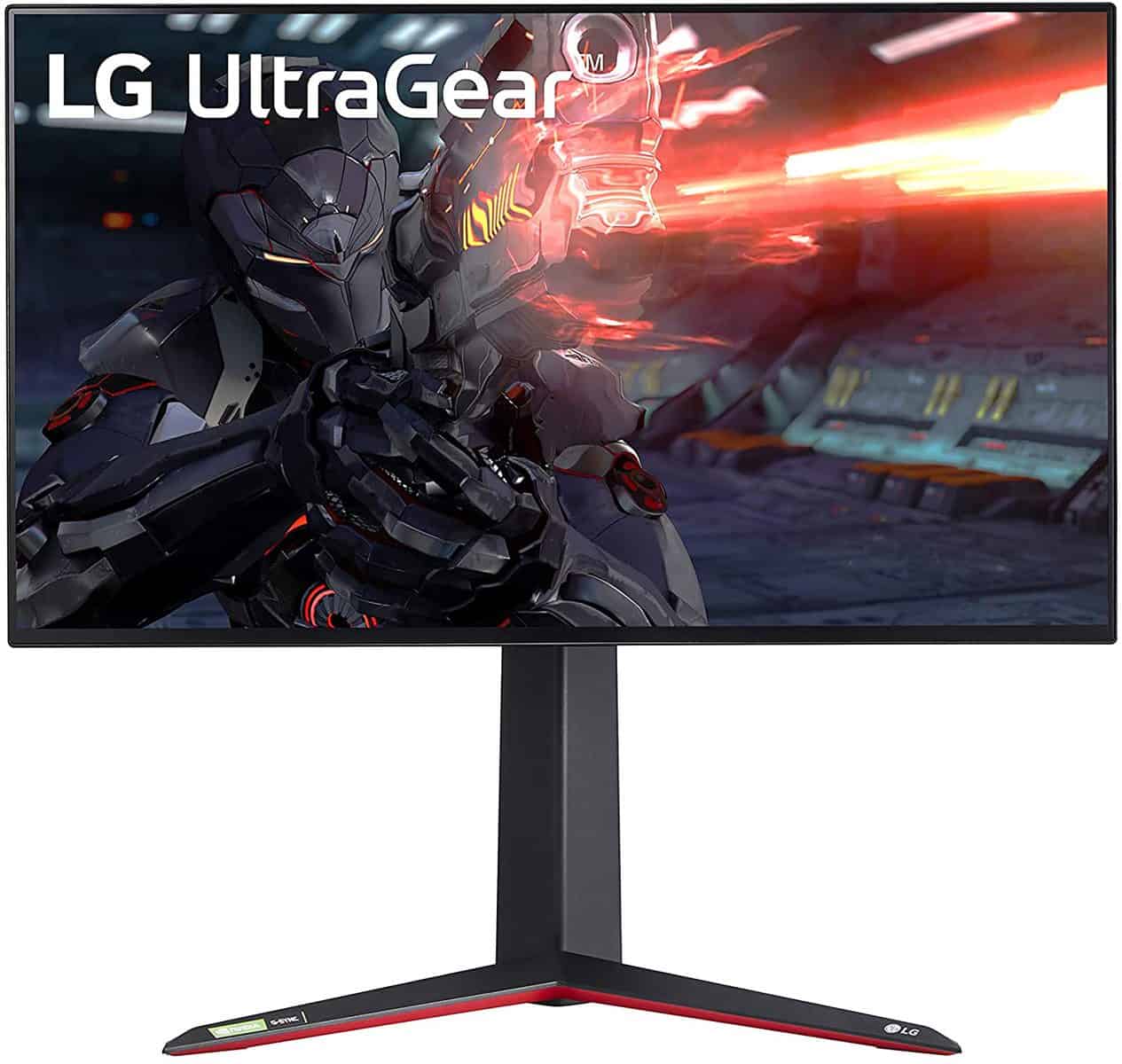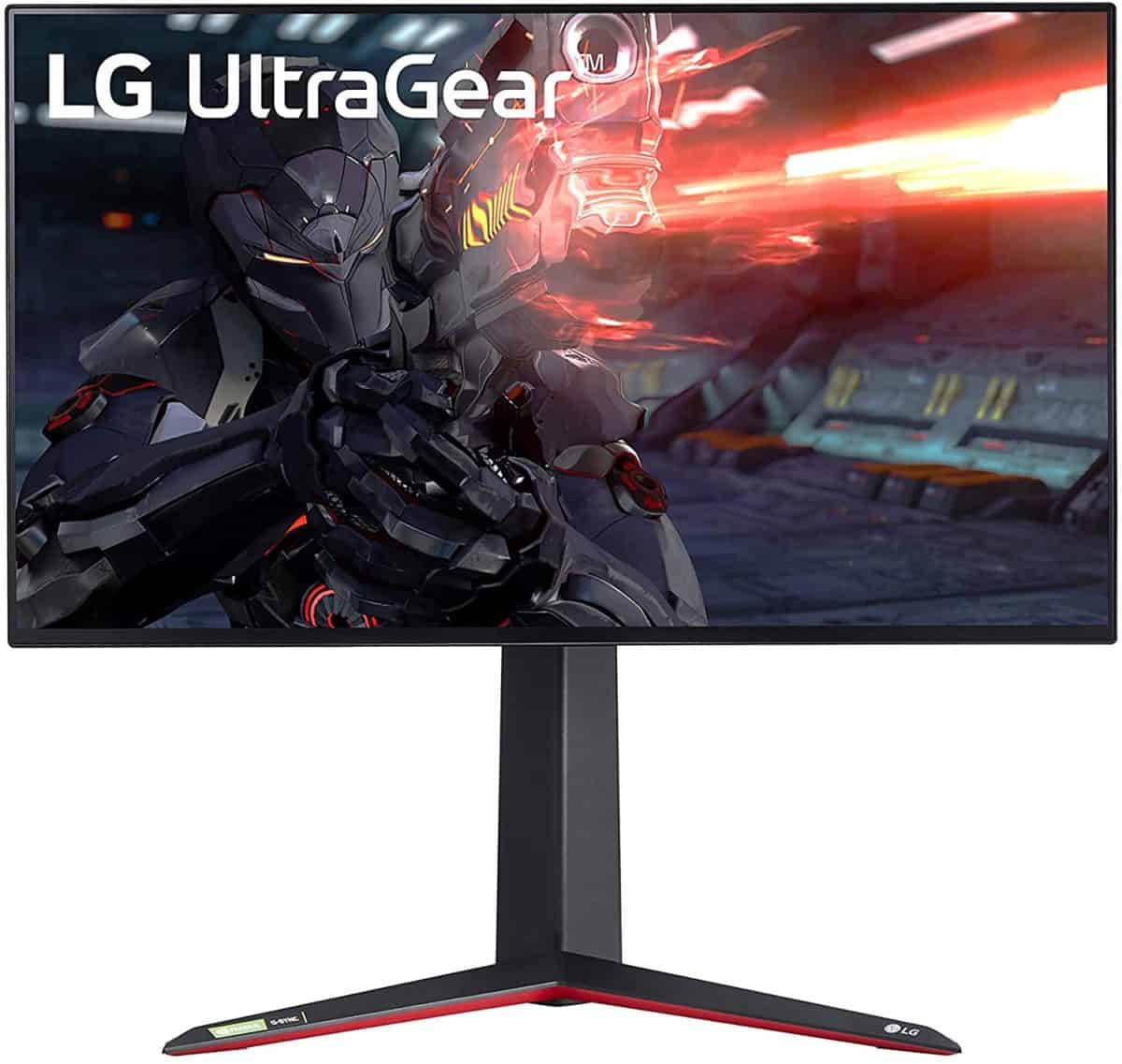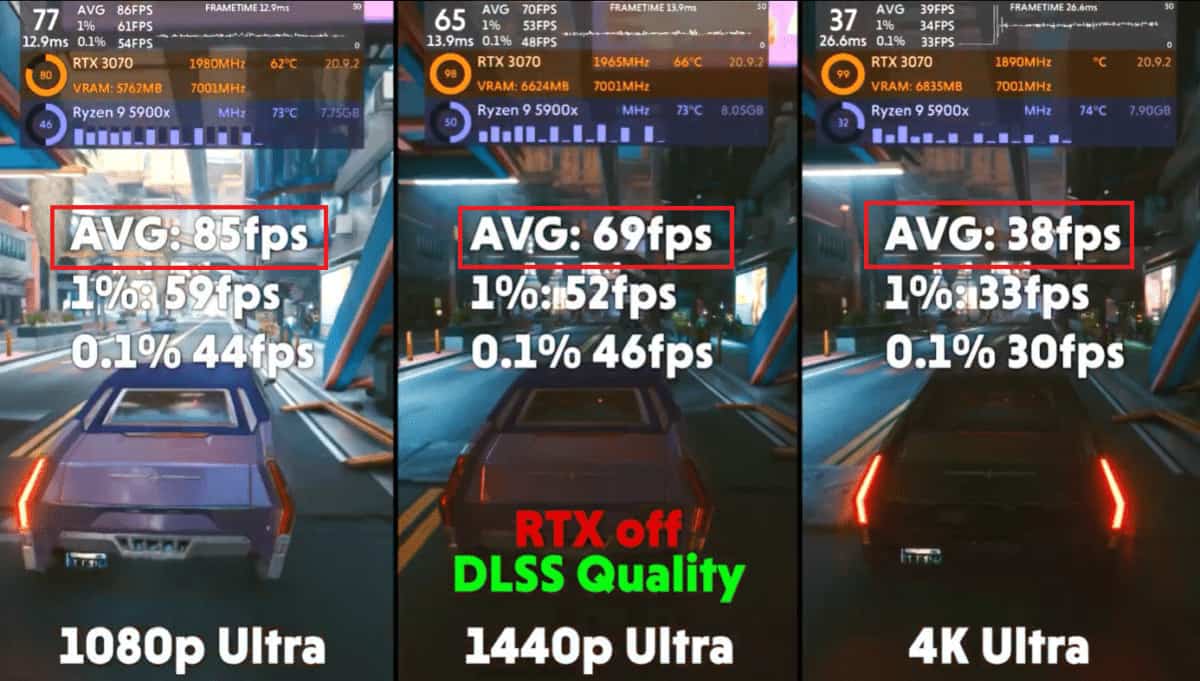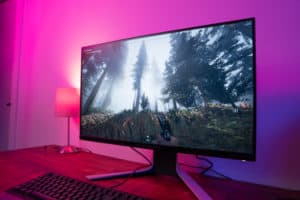Best 4K gaming monitor 2023: latest panels reviewed
Featuring 144Hz, high-end, HDMI 2.1, and the World's first mini LED panels!

Our team of experts have reviewed a substantial percentage of the market’s best 4K gaming monitors, and we can safely say that the LG 27GN950-B is the best all-round monitor for high resolution gaming. But there are plenty more to take a look at too!
Thanks to the arrival of new high-powered GPUs from both AMD and Nvidia – including a plethora of 4K-capable gaming consoles – the best 4K gaming monitor is now more sought after than ever before. With the ability to push 4K native resolutions at high frame rates, many gamers are scouring the web trying to find the best 4K gaming monitors the market has to offer. Alongside stunning image clarity, 4K monitors now come in a variety of backlight technologies, including Mini-LED, OLED, and QD-OLED options. That makes choosing this particular type of gaming monitor considerably harder – especially when you factor in just how many excellent 4K options reside in today’s market.
So, with plenty to get through, let’s waste no further time and dive into the best 4K gaming monitors!
Best 4K Gaming Monitor: products at a glance

LG 27GN950-B 27 Inch
Amazon

ASUS ROG SWIFT PG32UQX

Acer Nitro XV282K

ASUS TUF Gaming VG289Q

LG 27UK650-W
Best 4K Gaming Monitor: Buying Tips
Before we get into the nitty-gritty, we’re going to break down some of the top tips for buying one of the best 4K gaming monitors.
Below are some of the most important buying tips that will help you find the right gaming monitor for your needs:
- Next-gen Console gamers should prioritize HDMI 2.1 support
- Whilst 4K 144Hz gaming monitors are great for PC gaming (and coming down in price), the best options on the market will still set you back well over $900
- IPS panels offer the best color accuracy
- OLED displays are the most expensive but do offer the best color gamuts and contrast ratios
- Budget 4K gaming monitors will often have a max refresh rate of 60hz – not great for gaming
- 4K screen resolution offers the best image quality
Best 4K gaming monitor 2023: our top picks
Best 4K Gaming Monitor: Reviews
Below, we take a closer look at the market’s best 4K gaming monitors, highlighting the main features, specifications, and benefits below.
Best 4K gaming monitor: LG 27GN950-B

LG 27GN950-B 27 Inch
Amazon
- Excellent picture quality
- FreeSync support and G-Sync compatibility
- Exceptional response time
- Wide viewing angles
- Poor contrast ratio
- Doesn’t handle reflections well
The LG 27GN950-B gets our best 4K gaming monitor pick and for good reason. Not only does it offer a stunning 4K resolution picture quality and screen real estate, but it also brings exceptional response and refresh rates to the table as well.
Looking at the design, the 27GN950-B looks pretty similar to the other monitors within the LG Ultragear lineup – offering a sleek design that is balanced nicely with a sharp, angular stand. The rear of the monitor doesn’t really offer too much in terms of design features, apart from a circular halo that is finished with red and silver. The stand itself is a little disappointing from an ergonomics standpoint – providing only tilt, height, and rotational adjustments. The stand does have a little cable management system though and is equipped with a quick-release button for fast switching of stands.
Design aside, the LG 27GN950-B really excels when it comes to gaming performance. The 27inch display is the perfect size for most gaming scenarios, allowing users to become immersed in their virtual reality whilst playing. The rapid response time paired with the impressive 144Hz refresh rate makes for a very enjoyable gaming experience. That being said, you’ll have to be using a powerful GPU and DisplayPort if you want to get the most out of this monitor as it doesn’t offer HDMI 2.1 support. That said, with FreeSync variable refresh rate support and G-Sync compatibility, the monitor is almost completely void of any screen tear or other visual artifacts.
It performs quite poorly in the contrast and local dimming departments, making it not an ideal selection for dark-room players. That said, the IPS panel utilized in this monitor does offer up great color recreation and excellent viewing angles.
Best 4K Mini LED gaming monitor: ASUS ROG SWIFT PG32UQX

ASUS ROG SWIFT PG32UQX
- World’s First Mini LED Monitor
- 144Hz Refresh Rate
- IPS technology
- DisplayHDR 1400 compatible
- FALD with 1152 dimming zones
- 4ms response time
- Very expensive
The best 4K gaming monitor runner up goes to the ASUS PG32UQX – the world’s first Mini LED gaming monitor. If this list was based purely on performance, there’s a strong chance the PG32UQX would be at the top of the pile – boasting a 4K screen resolution alongside a 144Hz refresh rate, low response time, and VESA DisplayHDR1400 certification. However, the price tag makes it hard to recommend to the mass public – especially when it retails for just shy of $3,000.
Like all premium ASUS monitors, the PG32UQX offers up a stylish design that definitely leans more towards ‘gamey’ than boring. The triad stand is nicely styled and offers good balance with very little wobble. The front of the monitor fairly featureless, however, it does come with a cool OLED display that can be customized within the monitor’s OSD. The rear of the monitor offers a new(ish) style of ROG branding, with a large ROG RGB logo being the main focus. Inputs for this monitor include HDMI 2.0, DisplayPort 1.4 (DSC), and a USB HUB.
As for performance, it’s hard to say a bad word about this monitor. With a 144Hz refresh rate, low input lag, and HDR1400 support, you really do get the best of both worlds with this panel. The colors are extremely vibrant (thanks to the peak brightness that the HDR supports) and gameplay is liquidy smooth – no matter what style of game you’re playing. It also offers G-sync support which helps eradicate nasty screen artifacts like tearing – giving you as a gamer an even more immersive experience. A 160% sRGB color gamut that has been pre-calibrated to a deltaE <2 also makes both gaming and everyday entertainment a real treat.
Ultimately, if cash is no issue, this monitor should be high on your list of considerations.
Check out the Best 32 inch monitors here
Best 4K HDMI 2.1 monitor: Acer Nitro XV282K

Acer Nitro XV282K
- 4K gaming at 144Hz
- Great colour accuracy
- VRR support for next-gen consoles
- IPS panel with 1ms response time
- Decent Value for money
- Peak brightness is poor
- Doesn’t offer HDR
For console gamers that have been waiting for a 4K 144Hz monitor that supports HDMI 2.1, look no further – Acer has you covered with one of the best 4K gaming monitors we’ve tested.
Starting with the design, Acer has kept things pretty simple with this monitor – giving it a fairly basic design that is neither ‘gamey’ nor boring. Whilst it doesn’t offer the same premium styling (or feel) as the Predator series, it still offers a decent aesthetic that can be used in more scenarios – including offices. The rear of the monitor doesn’t really offer much in terms of design features, with a cylindrical stand being the standout feature.
Moving onto performance, you’ll be happy to learn that the XV282K doesn’t really compromise on that many areas when compared to the previous iterations. It offers the same 4K screen resolution alongside the same 144Hz refresh rate. Better still, it actually has better input lag and greater colors than many of the market’s similarly priced alternatives. So where does it fall short? Well, that’s in the HDR department. Unlike other monitors in this guide that provides stellar HDR1000 support, the same can’t be said for the XV282K. It doesn’t offer nearly as much brightness as you might like, making it fairly poor in bright room scenarios. That said, it does offer decent dark room gaming and supports VRR for both PS5 and Xbox Series X.
Overall, a really impressive little monitor that is great for console gamers looking to take their gameplay to the next level.
Check out the best HDMI 2.1 monitors here
Best budget 4K Gaming monitor: ASUS TUF Gaming VG289Q

ASUS TUF Gaming VG289Q
- Excellent price point
- Stand offers good versatility
- Good single-player 60Hz gameplay
- Power input lag
- Low refresh rate
Our budget 4K gaming monitor goes to the ASUS TUF VG289Q, a monitor that is both hit and miss when it comes to gameplay and entertainment purposes. Obviously, the main pro of this monitor is its price – however, with good colors and great picture quality right out the box, it also offers good value too.
Like all TUF Gaming monitors, the VG289Q comes equipped with a very subtle design that could be considered on the boring side – especially when compared to others in this guide. That said, when you consider the price point, it still feels extremely well built and provides good versatility for the most part. The stand comes equipped with height, tilt, swivel, and pivot functionality, allowing users to find the perfect viewing position no matter what the scenario.
From a gaming standpoint, the VG289Q probably isn’t the best in the world for fast-paced shooters like CS:GO and COD. That said, if you’re looking to play immersive single-player titles, there’s absolutely nothing wrong with a slower monitor such as this. It provides great colors right out the box alongside that characteristic IPS picture quality. Contrast ratio isn’t the best on this monitor, but that’s to be expected from an IPS panel.
Overall, for the price, you’d can’t really knock the ASUS TUF VG289Q when it comes to basic 4K gaming on a budget.
Best value 4K gaming monitor: LG 27UK650-W

LG 27UK650-W
- Supports AMD FreeSync technology
- Great color reproduction
- Fantastic IPS panel with HDR support
- Well priced
- Only 60Hz refresh rate
- No USB port
The last recommendation in this guide is our value pick – and it goes to the hugely popular LG 27UK650-W. Despite this monitor not quite living up to others in terms of performance, it does have plenty of benefits to its name – including a very affordable price tag.
Starting with the design, you’d have to say this was one of the standout features of this monitor. The stand offers a curved base finished in a silver brushed style – a nice change from the more common ‘V’ shaped stands that we’re used to. The silver finish works nicely with the black frame of the monitor to create a stylish look that would suit most office environments. The back of the monitor is almost entirely white, not really offering anything in terms of gaming aesthetics. Ultimately, you’d have to say this monitor leans more towards an office style rather than gaming – but that’s not a bad thing.
Looking at gaming, this monitor performs well for anyone looking to play at 60Hz – last-gen console gamers spring to mind. It offers up very low input lag and great colors right out the box. The IPS panel allows for good SDR peak brightness and it even comes equipped with HDR support – albeit not the greatest standard. The 4K screen resolution offers very good clarity and overall picture quality – making single-player titles all the more immersive. As always, contrast ratio isn’t the best and blacks do look gray when playing in a dark-room environment. For the price, however, it’s still a very good monitor.
Check out the best 27 inch monitors here.
Honorable mentions
- Eve Spectrum ES07D03: Despite a few flaws, the Eve ES07D03 still provides a very nice visual experience – characterized by thin bezels and a quick IPS panel. Eve Spectrum review
- ASUS PG32UQ: This high-end 4K gaming monitor offers up superb image quality and color accuracy thanks to the Quantum Dot layer it utilizes. ASUS PG32UQ review
- BenQ EW3280U: While this monitor features a stunning 4K UHD resolution, it doesn’t offer the speed found in some of the more premium options in this guide. BenQ EW3280U review
What is a 4K Monitor?
Alternatively known as UHD (ultra high definition), a 4K display is any monitor capable of producing a 4K resolution. In physical terms, a 4K resolution amounts to 3840 pixels horizontally by 2160 pixels vertically – that’s twice the clarity of 1440p or four times that of standard HD’s 1080p. Whilst this is great for picture quality and general clarity, it does add a great deal of stress to your PC’s hardware – leaving many people asking the question, is 4K actually worth it?
Best 1440p 240Hz monitor 2023 (Monthly updates)
Should I Buy A 4K Gaming Monitor?
Despite new hardware technology now having the ability to push native 4K resolutions at playable framerates, many individuals still find the best 4K monitors too overpowered for their gaming needs. Highly competitive esports players, for example, still favour quicker response times and less-intense resolutions over stunning picture clarity and increased levels of immersion. That being said, with decreasing costs and greater ability to run games at 4K resolution, many people are starting to consider a 4K gaming monitor as their next upgrade.
So, should you buy a 4K gaming monitor or not? Well, there are plenty of benefits that come with buying a 4K gaming monitor – the biggest being picture clarity. For those new to monitor technology, your screen resolution has a huge impact on picture quality and overall clarity. As we previously mentioned, screen resolution refers to the physical number of pixels your monitor can display at any given time. So, at 4K (3840 x 2160), the monitor displays 3840 pixels horizontally by 2160 pixels vertically. When comparing a 4K to a 1080p resolution (1920 x 1080), it’s easy to understand the benefits of 4K.
Also, with better picture quality usually comes greater levels of immersion. For gamers that like to play story-based games, immersion is a huge factor in their monitor selection. Luckily, 4K monitors are widely considered some of the most immersive on the market – only challenged by larger ultrawide monitors.
Furthermore, it’s not unusual to see 4K monitors offer wider color gamuts and generally better colors than other less-premium alternatives. 100% sRGB and wide coverage of both Adobe RGB and DCI-P3 are quite common in modern 4K panels. This not only makes them great for gaming but also makes 4K monitors fantastic for color-accurate work too. The increased screen real-estate will also allow you to multi-task more efficiently when using the desktop too.
Things To Expect When Buying The Best 4K Gaming Monitor
Like any hardware purchase, buying a 4K monitor for your gaming needs comes with a number of expectations. Below are the most realistic expectations that come hand-in-hand with a high-resolution monitor purchase:
Refresh Rates: A monitor’s refresh rate is one of the most important specifications to look out for. A good refresh rate can be the difference between a smooth gaming experience and something much less enjoyable. In today’s market, monitors can vary from 60Hz to 360Hz – with higher being better for gameplay smoothness.
That being said, 4K monitors are slightly behind when it comes to refresh rates, only really reaching heights of around 144Hz. Whilst this is fine for most scenarios, competitive gamers that look to gain any advantage over their competition won’t be happy with anything less than the best – which in today’s market is 360Hz.
Check out our guide on screen tear here.
Lower Framerates: That leads us nicely onto frame rates. As we discussed earlier, a 4K monitor showcases a huge amount of pixels when compared to lower quality 1080p and 1440p variants. Whilst this is great for picture quality, it’s not so great when it comes to the demand that is placed on your PC.
A lot of people will understand the drop in performance when moving from 1080p to 1440p – it’s an undeniable drop in FPS output that is clear for all to see. Well, the same drop can be expected when going from 1440p to 4K – if not more.
Your PC is put under great strain when playing games in high resolutions – working the graphics card much more intensely. For that reason, expect to see large drops in FPS when switching from lower resolutions upwards.
Price: Lastly, we must consider the price. Unfortunately, high-resolution capability is one of the most cost-effective specs a monitor comes equipped with – and not in a good way. The average cost of a 4K monitor in today’s market is much higher than any 1080p/1440p alternative.
So, if you’re in the market for a 4K monitor, don’t expect to get a good one on the cheap – they usually start at around $300, gradually getting more expensive with every high-end spec they offer.
HDR: Another feature of higher-end choices is High Dynamic Range. This only really works for any HDR content a movie or HDR games. These are far and few between but enhance the range and look of what you get to experience.
The HDR performance may vary, with a variety of ratings. Lower ones are not really worth it, whilst high ones increase the cost and power requirements. These are determined by the Vesa Displayhdr standard and so should be set to a standard.
Adaptive sync: What also might vary between different choices are the adaptive sync options that the displays support. Either AMD Freesync or Nvidia G-Sync might be supported by the display to improve the gaming experience as the refresh rate adapts to the frame rate of the video.
For everything else monitor related, why not check out our what to look for in a gaming monitor guide. We’ve even got a guide for how to measure a computer screen.
Backlight technology in 4K monitors
Until recently, the only real choice when it came to a 4K gaming monitor was LED.
LED backlight technology has been around for some time now, providing a decent viewing experience when paired with color and image-enhancing layers.
That said, LED isn’t the only backlight technology in town. Today’s market holds a plethora of alternative options that include Mini-LED backlight, OLED, and QD-OLED.
All three offer better visual qualities over the entry-level LED, including higher peak brightness, perfect infinite contrast, more accurate colors, and better viewing angles. With a varying range of dimming zones too.
Should you buy a 4K gaming TV instead?
When comparing 4K monitor vs 4K TV, there are plenty of things to consider. Both sides offer great gaming options, especially with 4K HDMI 2.1 TVs offering 4K 120Hz gameplay – aimed at the current generation of consoles. For monitors, that refresh rate can be bumped up a little bit to 144Hz, but you’ll need some of the best specs in your gaming PC to run at this kind of level right now. Despite that, 4K gaming monitors usually offer the best gaming performance. They have more gaming-focused features, with FreeSync and G-SYNC both commonplace.
On the other hand, 4K gaming TV can offer just as good image quality and larger screen size for cheaper. A 4K TV may not be ideal for desktop setup though, as monitors have better levels of customization – height adjustment, swivel, and tilting mechanisms are what we’re thinking of here. Monitors are simply better sized for desktop use, with common sizes being 24-inch, 27-inch, and 32-inch.
Best 4K Gaming Monitor FAQs
Is a 4K gaming good for gaming?
If your PC is capable of pushing the frame rates required for smooth gameplay, a 4K gaming monitor can be an incredibly attractive prospect.
Single-player titles can be extremely immersive when using large 4K monitors as they increase picture quality and image clarity exponentially.
Of course, this comes at a price, as most 4K gaming monitors aren’t nearly as quick as esports-tailored alternatives.
Are 4K gaming monitors expensive?
The 4K gaming monitor is one of the most expensive panel types you can buy.
While size, response time, and refresh rate all have an effect on price, the resolution is arguably the most impacting – seeing prices jump up massively.
Do 4K 144Hz monitors exist?
As monitor technology has evolved over the years, we’ve started to see high-end resolutions paired with high refresh rates more frequently.
In today’s market, there are a plethora of 4K 144Hz gaming monitors available. These work extremely well with the next-gen consoles that are so popular at the moment, offering up HDMI 2.1 support for the best console gaming experience.
Best 4K gaming monitor : Final Word
So, there you have it, our comprehensive guide on the best 4K gaming monitors. The technology around 4K monitors is only going to get better, so investing in a 4K gaming monitor is a future-proof idea. The only thing left to do is, decide whether or not a high-end 4K display is right for your specific needs.
Avid competitive players will usually opt for monitors with quicker refresh rates, making one of the best 240Hz monitors a more attractive prospect. However, if you prioritize picture quality and general immersion, a 4K monitor might be exactly what you’re looking for. Just remember, the extra pixels that come with a 4K monitor will put a lot more strain on your PC. The last thing you want is to buy a shiny new 4K monitor and only be able to push 30FPS in your favorite games. so considering the best graphics cards might be required.
2 thoughts on “Best 4K gaming monitor 2023: latest panels reviewed”
Comments are closed.
WePC is reader-supported. When you buy through links on our site, we may earn an affiliate commission. Learn more












Hi Nathan, thanks for the comment. What graphics card do you have in your new build? If you look at your GPU, you will see the connection types available on the back (or look at the product specifications amazon/manufacturer website). The connection type on the graphics card needs to be shared by the monitor.
I have a question this will be my very first pc build and i have no idea how monitors plug into the pc like is it a vga port or hdmi like i dont know?